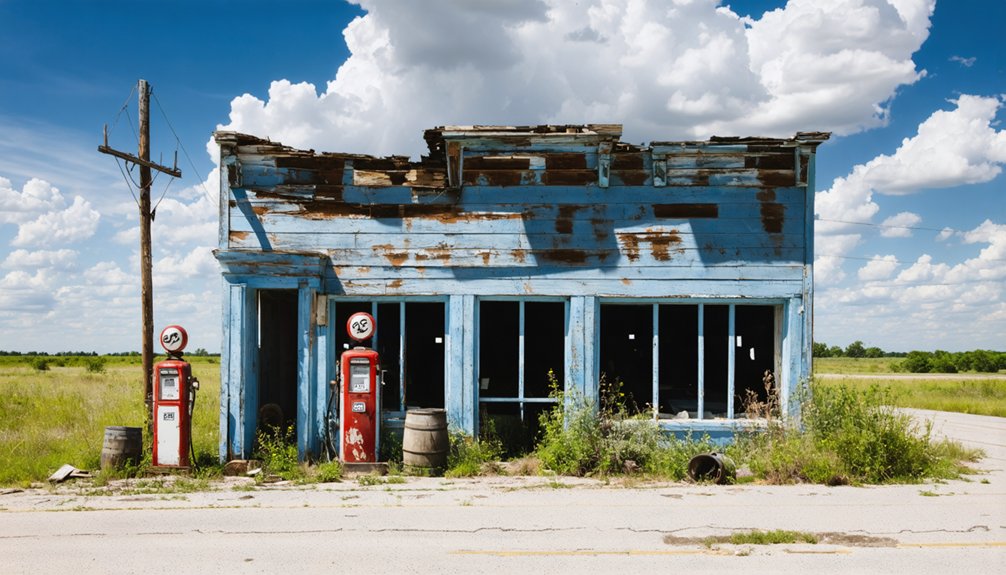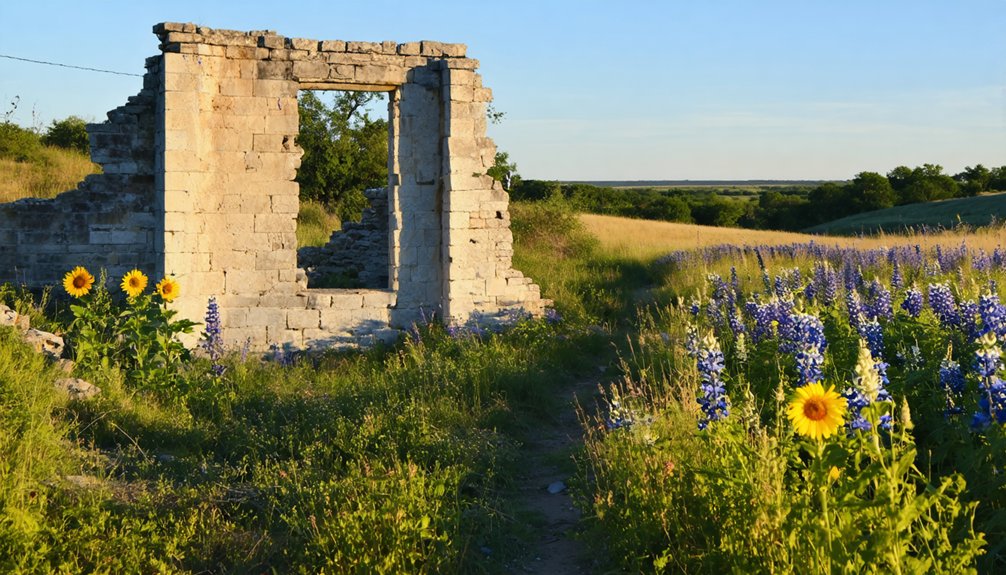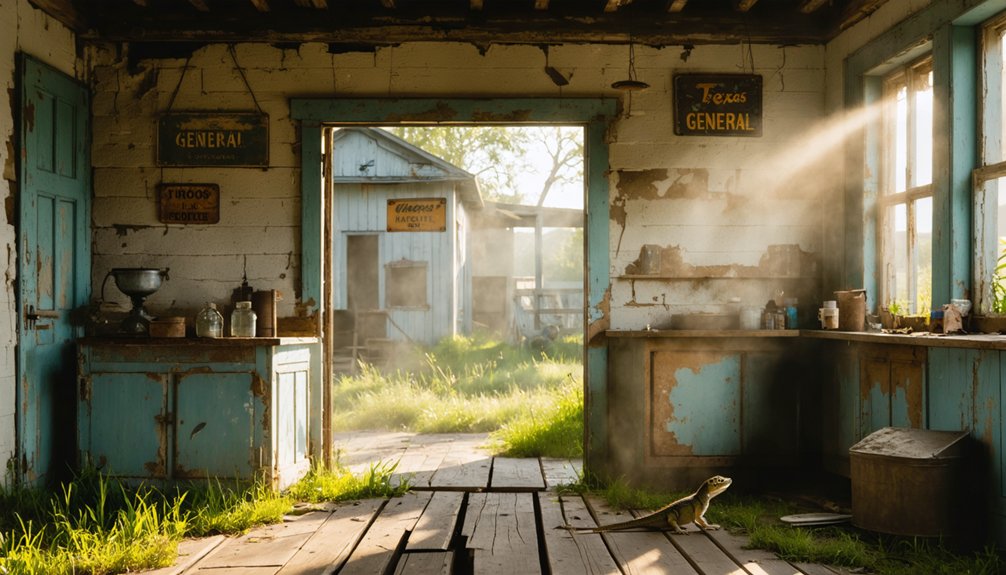You’ll find two distinct Mount Olive ghost towns in Texas – one in Lavaca County (est. 1838) and another in Mills County (est. 1877). The Lavaca settlement centered around a Baptist church-school, while the Mills location flourished with the Sunset Sawmill, which produced 65,000 board feet of lumber daily by 1889. Both towns declined dramatically after the sawmill’s closure in 1907, leaving only cemeteries and natural reclamation as evidence of their once-thriving communities. These abandoned settlements hold deeper stories beneath their quiet facades.
Key Takeaways
- Mount Olive, Texas transformed from a thriving lumber town of 1,200 people to a ghost town after its primary economic engine, Sunset Sawmill, closed.
- The town’s decline began after a devastating fire in 1907 destroyed the sawmill, leading to immediate dismantling of company housing and infrastructure.
- Sunset Sawmill, established in 1881, was once one of East Texas’s largest lumber operations, producing 65,000 board feet daily at its peak.
- Mount Olive Cemetery, established in 1922, remains as a historical marker with over 300 graves documenting the community’s African American heritage.
- Nature has reclaimed the former townsite, with native vegetation and forest growth replacing the once-bustling industrial and residential areas.
A Tale of Two Mount Olives: Historical Origins
While Texas history includes several communities named Olive, two distinct Mount Olives emerged during the 19th century in different regions of the state.
You’ll find the older Mount Olive in Lavaca County, established around 1838 when the Culpepper family settled there. This community quickly developed with a Baptist church that doubled as a school, and later added J.E. Hranitzky’s store, marking its commercial beginnings. S.C. Olive and John A. Sternenberg established another Olive community that operated a successful sawmill business in 1876.
The second Mount Olive, located in Mills County, came to life in 1877 when pioneers like John Neal, J.J. Wilcox, and Thomas Huckabee Sr. settled in what was then known as “No Man’s Land.” Like the Mississippi town of Rodney, the community’s fortunes were tied to its strategic location during the Civil War.
This settlement grew around a Primitive Baptist Church, which became the heart of community life during the post-Civil War expansion into Central Texas.
The Rise and Fall of the Sunset Sawmill
At its peak in 1889, you’d find the Sunset Sawmill churning out an impressive 65,000 board feet of lumber daily in Olive, Texas, powered by massive pine logs up to 48 inches in diameter.
The Olive and Sternenberg company established the mill’s operations in 1881, marking the beginning of the town’s industrial era.
You could spot four Baldwin and Shay locomotives hauling timber along the 9-mile tram road, keeping the mill’s robust production schedule on track.
Your visit to Olive today would reveal only ghostly remnants of this once-thriving operation, as the mill’s closure led to the town’s eventual abandonment, leaving behind charred ruins and deteriorating buildings by the mid-20th century.
The depletion of local timber resources ultimately sealed the fate of this prosperous lumber town.
Peak Production Era
During its peak production years, the Sunset Sawmill emerged as one of East Texas‘ largest lumber operations after its establishment in 1881 by Olive and Sternenberg Company.
The mill’s sawmill innovations included state-of-the-art steam engines and drying kilns purchased from E. P. Allis and Co., revolutionizing timber production in Hardin County. The mill’s success led to the creation of a post office in 1884, establishing Olive as a permanent settlement. The mill maintained a substantial lumber inventory of 5,000,000 feet in its yard during peak operations.
The operation’s impressive scale included:
- A 9-mile tram road serviced by four Baldwin and Shay locomotives
- 40,000 acres of prime pinewood timber, including trees up to 48 inches in diameter
- Modern facilities with advanced lumber drying kilns
- A thriving workforce of nearly 1,000 residents, including 172 Black workers
The mill town of Olive quickly became a bustling industrial hub, transforming the East Texas pineywoods into a major lumber-producing region under S. C. Olive’s direction.
Mill Closure Impact
Once the Sunset Sawmill closed its gates, the economic foundation of Mount Olive crumbled, triggering a devastating chain of events that transformed the bustling industrial town into a ghost town.
Without the mill’s jobs, you’d have witnessed Mount Olive’s rapid decline from 1,200 residents to near abandonment. Local businesses shut down, property values plummeted, and tax revenues dried up. Similar to how the Great Depression impacted local businesses and population, Mount Olive was hit hard by their industrial decline.
Despite attempts at economic revitalization strategies, the town’s infrastructure deteriorated as railroad systems fell into disrepair and public services dwindled. Community resilience initiatives couldn’t prevent the closure of schools and churches as families migrated to other Texas towns seeking industrial work.
The mill’s shutdown also crippled the region’s timber industry, as it had been a major processor of local pine. The second fire in 1907 permanently ended all milling operations in the town.
Today, only the cemetery remains as a memorial to Mount Olive’s former significance.
Community Life and Early Development
While the mountain landmark provided its name in 1877, Mount Olive‘s true foundation emerged through the pioneering efforts of settlers John Neal, J.J. Wilcox, and Thomas Huckabee, Sr. Their vision centered around establishing a Primitive Baptist church that quickly became the heart of community gatherings and religious significance.
- The church served dual purposes as both a place of worship and a schoolhouse.
- Early settlers built their lives around agriculture and nearby timber resources.
- J.E. Hranitzky’s store provided essential goods to the growing settlement.
- Social life revolved around church activities and school events.
The settlement’s proximity to transportation routes helped shape its early development, while immigrant influences added cultural diversity, evidenced by German-language epitaphs in local graveyards. Local families supported their thriving community which reached a population of about 500 residents during its peak years.
The community remained small but self-sufficient, with families supporting each other through shared faith and mutual assistance. As documented in A History of Cherokee County, Mount Olive’s development represented a typical pattern of early Texas settlements.
Cemetery Traces and Cultural Heritage
Mount Olive Cemetery stands as a tribute to African American cultural heritage in Stephenville, Texas. Established in 1922 by the Colored Burial Association, the cemetery contains over 250 known burials and 50 unmarked graves, revealing the cultural significance of this historic site.
You’ll find evidence of traditional burial practices through the headstones and markers, which tell stories of family lineages and community values. Texas State University’s forensic anthropologists have used ground-penetrating radar to map the gravesites, while Tarleton State University works to preserve this cultural landmark.
The cemetery’s connection to St. John’s Baptist Church highlights how faith and burial customs strengthened community bonds. Despite segregation’s impact, Mount Olive Cemetery represents the resilience and enduring spirit of Stephenville’s African American community.
Economic Transformation and Abandonment

You’ll find Mount Olive’s economic collapse directly tied to the rapid depletion of timber resources, as Olive, Sternenberg and Co.’s daily 100,000-foot log harvest proved unsustainable by 1910.
The mill’s final log processing in March 2012 triggered an immediate dismantling of company housing and infrastructure, leaving the once-bustling timber town abandoned.
While the land later shifted to gas and oil leasing, Mount Olive’s dense forest has now reclaimed the former industrial site, with only scattered cemetery markers hinting at its brief but intense period of prosperity.
Resource Depletion Impact
As timber reserves began dwindling around 1910, the thriving communities of Mount Olive and Olive, Texas faced devastating economic consequences.
Poor resource management led to the rapid depletion of timber that had sustained Olive’s Sunset Sawmill, which processed up to 100,000 feet of logs daily. The lack of economic sustainability became evident as the region’s primary industry collapsed, despite a brief reprieve from a 3,600-acre pine timber acquisition.
The impact of resource depletion manifested in several ways:
- Olive’s population plummeted from 1,200 to nearly zero within a few years
- Mill buildings and company housing were quickly dismantled or abandoned
- Post offices closed by the 1920s, marking the end of crucial community services
- Land ownership shifted from active production to estates and limited leasing arrangements
Mill Town’s Swift Decline
The once-thriving mill town experienced a dramatic downfall between 1910-1912 when its primary economic engine, the Sunset Sawmill, shut down operations. You would’ve witnessed nearly 1,000 residents, including a substantial Black community, rapidly abandoning their homes as timber depletion forced the mill’s closure.
Mount Olive’s economic vulnerability became starkly apparent as the town’s infrastructure crumbled. By the 1920s, you’d find the post office shuttered and company housing deserted.
Despite the presence of railroad connections and modest agricultural activity, the town couldn’t survive without its timber industry. The landscape quickly reclaimed the settlement, leaving only silent cemeteries and scattered tombstones as evidence of the former community’s existence.
Post-Industrial Forest Recovery
Since Mount Olive’s abandonment in the 1920s, nature has steadily reclaimed the former mill town’s landscape through a complex process of forest regeneration.
You’ll find evidence of soil restoration efforts replacing the failed olive orchards that once dominated these Blackland Prairie soils. The land’s transformation from industrial agriculture to forest recovery showcases nature’s resilience.
Key aspects of Mount Olive’s ecological restoration include:
- Fast-growing sycamore trees leading the forest recovery, reaching impressive heights in single seasons
- Natural processes jumpstarting soil biological activity and nutrient cycling
- Existing irrigation infrastructure supporting new forest growth
- Integration of sustainable forestry through projects like Arbor Gasm
The restoration work adapts to past infrastructure rather than reshaping the land, allowing nature to heal while preserving the site’s historical layout.
Geographic Features and Natural Reclamation

Located within the Texas coastal plain region, Mount Olive’s terrain features gently rolling hills and fertile soils that once supported thriving agricultural operations.
You’ll find the landscape dotted with natural prairie and woodland typical of Lavaca County, while small creeks weave through the moderate elevations that slope toward the Colorado River basin.
Nature’s reclaiming power is evident throughout Mount Olive’s boundaries. Where farms and buildings once stood, native grasses, shrubs, and mesquite trees have taken root.
Abandoned settlements slowly fade as resilient native plants steadily reclaim the landscape, erasing human footprints beneath waves of natural regrowth.
This ecological recovery has created new wildlife corridors, providing habitat for deer, birds, and small mammals. The natural vegetation’s return helps stabilize the soil and control erosion, while seasonal rainfall patterns continue to shape the land’s gradual transformation back to its natural state.
Frequently Asked Questions
What Happened to the Descendants of the Original Mount Olive Settlers?
Like seeds scattered by wind, your descendant stories spread far and wide. You’ll find family legacies dispersed to nearby towns, cities, and westward regions, seeking better jobs after local industries declined.
Were There Any Major Fires or Natural Disasters in Mount Olive?
You won’t find any recorded fire incidents or disaster impact in historical records. The town’s changes came from economic shifts rather than natural catastrophes, with structures like the Baptist church surviving intact.
How Did Local Native American Tribes Interact With Mount Olive Settlers?
You’ll find that Tonkawa tribes maintained peaceful trade relationships with Mount Olive settlers, offering cultural exchange and protection, while Comanche groups remained distant and occasionally hostile during the settlement period.
What Kind of Wildlife Now Inhabits the Abandoned Mount Olive Area?
You’ll find diverse wildlife species thriving in Mount Olive’s abandoned habitats, including white-tailed deer, coyotes, bobcats, Mexican long-nosed bats, red-tailed hawks, and various snakes among the overgrown ruins.
Did Mount Olive Have Any Connections to the Civil War?
You’ll find historical significance in Dr. Samuel Flowers, who served as a Civil War surgeon before settling in Mount Olive, plus the town’s churches and plantations supported Texas’s wartime agricultural economy.
References
- https://www.beaumontenterprise.com/photos/article/Charred-remains-of-Olive-Texas-2142696.php
- http://www.wtblock.com/olivetexas.htm
- https://pastmaps.com/explore/us/texas/lavaca-county/mount-olive/hiking-exploration
- https://en.wikipedia.org/wiki/List_of_ghost_towns_in_Texas
- https://www.texasalmanac.com/places/mount-olive
- https://www.tshaonline.org/handbook/entries/mount-olive-tx-mills-county
- https://www.texasescapes.com/TexasHillCountryTowns/MountOliveTexas.htm
- https://www.texasescapes.com/WTBlock/Olive-Hardin-County-Texas.htm
- https://mississippifolklife.org/articles/haunted-by-a-ghost-town-the-lure-of-rodney-mississippi
- https://www.tshaonline.org/handbook/online/articles/hrmzy



